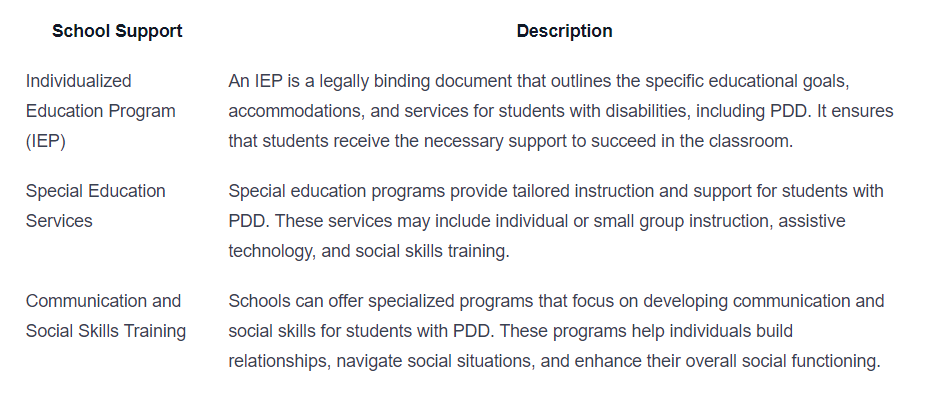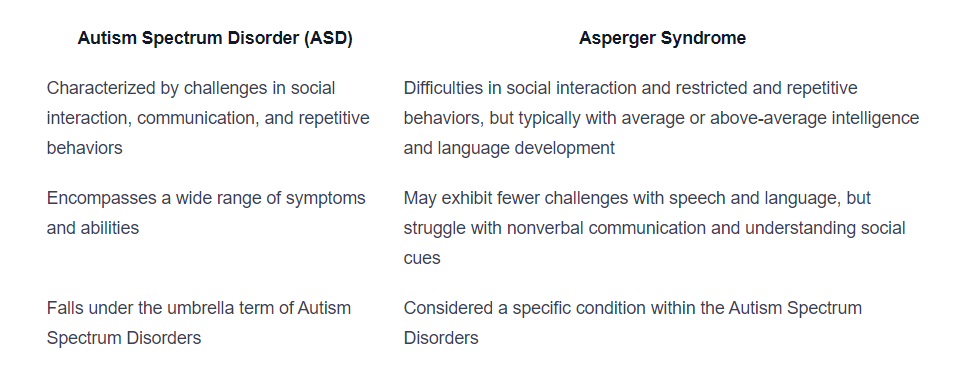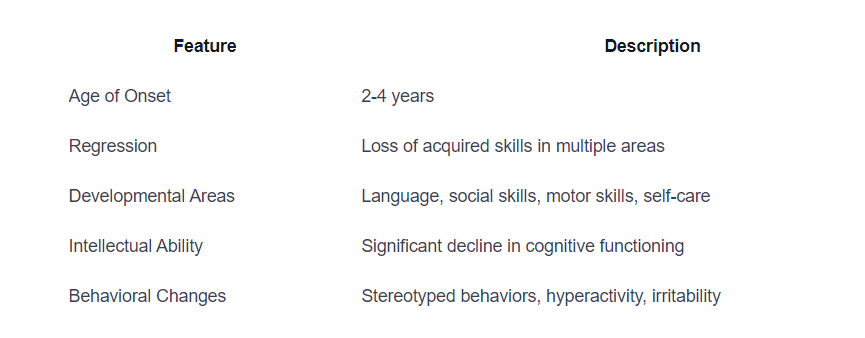Differences: Autism and Pervasive Development
Demystifying Autism and Pervasive Developmental Disorders: Understand the differences and find clarity in diagnosis and symptoms.

Understanding Autism and Pervasive Developmental Disorders
Autism and Pervasive Developmental Disorders (PDD) are terms used to describe a range of neurodevelopmental conditions that affect individuals in various ways. In this section, we will define both autism and pervasive developmental disorders to provide a clearer understanding of these conditions.

Defining Autism
Autism, also known as Autism Spectrum Disorder (ASD), is a complex developmental disorder characterized by challenges in social interaction, communication, and repetitive behaviors. It is a lifelong condition that affects individuals differently, with a wide range of abilities and challenges.
The diagnostic criteria for autism include persistent deficits in social communication and interaction across multiple contexts. These deficits may manifest as difficulties in understanding and using nonverbal communication, challenges in developing and maintaining relationships, and a lack of social-emotional reciprocity.
Defining Pervasive Developmental Disorders
Pervasive Developmental Disorders (PDD) is an umbrella term that encompasses several related conditions, including Autism Spectrum Disorder (ASD), Asperger Syndrome, Rett Syndrome, and Childhood Disintegrative Disorder. These disorders share some similar characteristics but also have distinct features that differentiate them from one another.
PDD refers to a group of disorders characterized by impairments in social interaction, communication, and restricted or repetitive behaviors. Each disorder within the PDD category has its own specific diagnostic criteria and unique set of symptoms.
To better understand the differences between autism and other pervasive developmental disorders, let's explore each disorder in more detail in the following sections.
Key Differences
When it comes to understanding autism and pervasive developmental disorders, it's important to be aware of the key differences between these two conditions. These differences can be observed in the diagnostic criteria and symptomatology associated with each disorder.
Diagnostic Criteria
The diagnostic criteria for autism and pervasive developmental disorders vary slightly. Autism, as defined by the Diagnostic and Statistical Manual of Mental Disorders (DSM-5), is characterized by persistent deficits in social communication and interaction, as well as restricted, repetitive patterns of behavior, interests, or activities.
On the other hand, pervasive developmental disorders refer to a group of disorders that share similar characteristics with autism but may have some distinguishing features. These disorders include Asperger syndrome, Rett syndrome, and childhood disintegrative disorder, among others. Each disorder has its own specific diagnostic criteria and may have additional requirements beyond those of autism.
To provide a clearer understanding, here is a table highlighting the diagnostic criteria for autism and two pervasive developmental disorders:

Symptomatology
While autism and pervasive developmental disorders share some similar symptoms, there are also distinguishing factors in terms of symptomatology.
Autism is characterized by a wide range of symptoms that can vary in severity and presentation. These symptoms may include challenges in social interaction, difficulties with communication (verbal and nonverbal), repetitive behaviors, sensory sensitivities, and specific interests or fixations.
Pervasive developmental disorders, such as Asperger syndrome, Rett syndrome, and childhood disintegrative disorder, have their own unique symptomatology. For example, individuals with Asperger syndrome may have difficulties with social interaction and communication, but often have average or above-average intelligence and may display intense interests in specific subjects.
To further illustrate the differences, here is a table comparing some of the key symptoms associated with autism and Asperger syndrome:

Understanding the key differences between autism and pervasive developmental disorders can help individuals and families navigate the complexities of these conditions. It's important to consult with healthcare professionals for accurate diagnosis, as well as to seek appropriate support and resources tailored to each individual's needs.
Autism Spectrum Disorders
Within the realm of pervasive developmental disorders, two significant categories are Autism Spectrum Disorder (ASD) and Asperger Syndrome. Let's delve into the defining characteristics of each.
Autism Spectrum Disorder (ASD)
Autism Spectrum Disorder (ASD) is a neurodevelopmental disorder characterized by persistent challenges in social interaction, communication, and restricted or repetitive patterns of behavior. Individuals with ASD may exhibit a wide range of symptoms and abilities, which is why it is referred to as a spectrum disorder.
ASD encompasses several conditions previously diagnosed separately, such as autistic disorder, childhood disintegrative disorder, and pervasive developmental disorder-not otherwise specified (PDD-NOS). The shift to the umbrella term ASD reflects the understanding that these conditions share common features.
Key features of Autism Spectrum Disorder include difficulties with social communication and interaction, repetitive behaviors, and a preference for routine. The severity of these symptoms can vary widely among individuals with ASD.
Asperger Syndrome
Asperger Syndrome is another condition falling under the umbrella of Autism Spectrum Disorders. It is characterized by difficulties in social interaction and restricted and repetitive patterns of behavior and interests. However, individuals with Asperger Syndrome typically have average or above-average intelligence and language development.
Compared to individuals with other forms of ASD, those with Asperger Syndrome may have fewer difficulties with speech and language. However, they often struggle with nonverbal communication, understanding social cues, and maintaining reciprocal relationships.
To summarize the differences between Autism Spectrum Disorder and Asperger Syndrome, the table below provides a concise overview:

Understanding the distinctions between these Autism Spectrum Disorders is essential in recognizing and supporting individuals with these conditions. By acknowledging their unique strengths and challenges, we can foster a more inclusive and understanding society.
Pervasive Developmental Disorders
While autism spectrum disorder (ASD) is a well-known condition under the umbrella of pervasive developmental disorders (PDD), there are other disorders that fall within this category as well. Two notable examples of pervasive developmental disorders are Rett syndrome and childhood disintegrative disorder. Let's explore these disorders in more detail.
Rett Syndrome
Rett syndrome is a rare genetic disorder that primarily affects females. It is characterized by a progressive loss of purposeful hand skills, communication abilities, and social engagement. Rett syndrome typically begins to manifest between 6-18 months of age, with a regression in skills that were previously acquired.
Here are some key features and characteristics of Rett syndrome:

It's important to note that Rett syndrome is caused by mutations in the MECP2 gene. While there is currently no cure for Rett syndrome, supportive care and therapies can help manage the symptoms and improve the individual's quality of life.
Childhood Disintegrative Disorder
Childhood disintegrative disorder, also known as Heller's syndrome, is a rare condition characterized by a significant loss of previously acquired skills in multiple areas of development. This disorder typically appears in early childhood, usually between the ages of 2 and 4 years.
Here are some key features and characteristics of childhood disintegrative disorder:

Childhood disintegrative disorder is a rare condition, and its cause is not yet fully understood. Treatment for this disorder focuses on managing symptoms and providing support to individuals and their families.
Understanding the differences between autism and other pervasive developmental disorders is crucial for accurate diagnosis and appropriate intervention. By recognizing the unique characteristics of each disorder, healthcare professionals and caregivers can provide tailored support and resources to individuals with these conditions.
Treatment Approaches
When it comes to managing autism and pervasive developmental disorders, a combination of treatment approaches is often employed to address the unique needs of individuals. Two common treatment approaches for these conditions are behavioral therapies and medication options.
Behavioral Therapies
Behavioral therapies play a fundamental role in the treatment of autism and pervasive developmental disorders. These therapies aim to address various challenges associated with these conditions, such as communication difficulties, social skills deficits, and repetitive behaviors. The goal is to enhance functional skills and improve overall quality of life.
There are several types of behavioral therapies that have proven to be effective in treating autism and pervasive developmental disorders. Some of the commonly used ones include:
- Applied Behavior Analysis (ABA): ABA is a structured therapy that focuses on behavior modification through positive reinforcement. It aims to teach individuals new skills and reduce problem behaviors by breaking them down into smaller, manageable steps.
- Social Skills Training: This therapy focuses on developing social interaction and communication skills. It helps individuals with autism and pervasive developmental disorders learn appropriate social behaviors, such as making eye contact, initiating conversations, and understanding social cues.
- Cognitive Behavioral Therapy (CBT): CBT is a form of talk therapy that helps individuals identify and change negative thought patterns and behaviors. It can be particularly beneficial for individuals with autism and pervasive developmental disorders who experience anxiety or difficulty managing their emotions.
Medication Options
In some cases, medication may be prescribed as part of the treatment plan for individuals with autism and pervasive developmental disorders. Medications are typically used to manage specific symptoms or co-occurring conditions that may accompany these disorders, such as attention deficit hyperactivity disorder (ADHD), anxiety, or depression.
It's important to note that medication is not a cure for autism or pervasive developmental disorders. However, it can help alleviate certain symptoms and improve overall functioning. The specific medications prescribed will vary depending on the individual's symptoms and needs.
Here are some common types of medications that may be used:

It's important to note that medication should always be prescribed and monitored by a qualified healthcare professional, such as a psychiatrist or pediatrician. The decision to use medication as part of the treatment plan should be made based on an individual's specific needs and in consultation with their healthcare team.
By combining behavioral therapies and, when necessary, medication options, individuals with autism and pervasive developmental disorders can receive comprehensive treatment to support their overall development and well-being. It's important to work closely with healthcare professionals to determine the most appropriate treatment approach for each individual's unique needs.
Support and Resources
When it comes to autism and pervasive developmental disorders, support services and educational programs play a crucial role in providing assistance and resources to individuals and families. These services aim to enhance the quality of life for individuals with these conditions and promote their overall development. In this section, we will explore the support services and educational programs available for individuals with autism and pervasive developmental disorders.
Support Services
Support services encompass a wide range of resources and programs designed to assist individuals with autism and pervasive developmental disorders. These services may include:
- Therapeutic Interventions: Various therapeutic interventions, such as speech therapy, occupational therapy, and behavioral therapy, can help individuals develop essential skills, improve communication, and manage challenging behaviors.
- Support Groups: Support groups provide a safe and understanding environment for individuals with autism and their families to connect with others who share similar experiences. These groups offer emotional support, share knowledge, and provide valuable guidance.
- Parent Training and Education: Parent training programs equip parents and caregivers with the knowledge and skills they need to support their child's development effectively. These programs focus on understanding the unique challenges associated with autism and pervasive developmental disorders and provide strategies for managing them.
- Respite Care: Respite care services offer temporary relief to caregivers by providing support from trained professionals or volunteers. This allows caregivers to take a break while ensuring that their loved ones with autism or pervasive developmental disorders receive the care they need.
Educational Programs
Educational programs are essential for individuals with autism and pervasive developmental disorders to acquire knowledge, skills, and social interactions. These programs can be tailored to meet the unique needs of each individual and may include:
- Special Education Classes: Special education classes provide a structured learning environment specifically designed for individuals with autism and pervasive developmental disorders. These classes focus on individualized instruction, sensory integration, and social skills development.
- Individualized Education Programs (IEPs): IEPs are personalized plans developed for students with disabilities, including autism and pervasive developmental disorders. These plans outline specific goals, accommodations, and support services to help students succeed in the educational setting.
- Transition Programs: Transition programs assist individuals with autism and pervasive developmental disorders in transitioning from school to adulthood. These programs focus on teaching life skills, vocational training, and facilitating community integration.
- Inclusion Programs: Inclusion programs promote the integration of individuals with autism and pervasive developmental disorders into mainstream educational settings. These programs provide support and accommodations to ensure that individuals can fully participate in academic and social activities alongside their peers.
By accessing support services and educational programs, individuals with autism and pervasive developmental disorders can receive the assistance and resources they need to thrive. These services and programs play an integral role in promoting their well-being, enhancing their abilities, and facilitating their overall development.
Sources
https://www.ninds.nih.gov/health-information/disorders/pervasive-developmental-disorders
https://www.medicinenet.com/differences_autism_and_pervasive_development/article.htm
https://my.clevelandclinic.org/health/diseases/pervasive-developmental-disorders
Similar articles
We’re here to help you

Our team is here to assist you in this process. Contact us for any assistance.
it’s easy to apply
We Accept Most Insurances
Our in-network insurance partnerships make ABA therapy more accessible to families throughout our service areas.







Our Insurance Process
We'll request your insurance details to help us verify your plan's coverage for ABA therapy. Once we've received this information, we'll walk you through your benefits, including copayments, deductibles and out-of-pocket maximums, so you know what to expect in advance.
Our team will then handle the preauthorization and all the necessary paperwork.
.svg)





















.jpeg)

































.jpeg)




.jpeg)







.jpeg)











.jpeg)
















